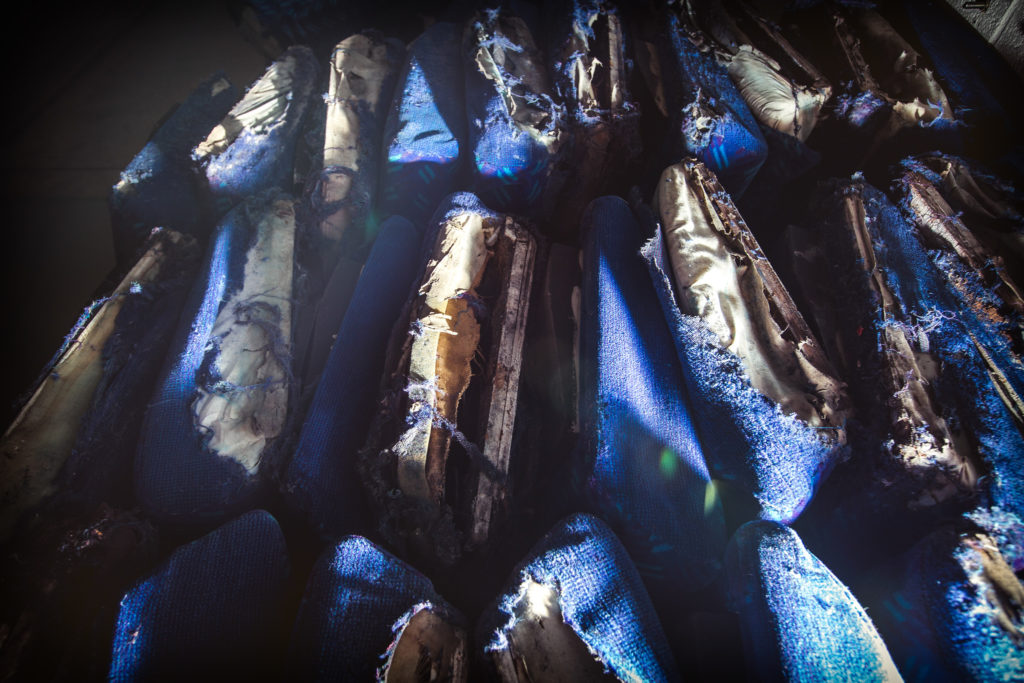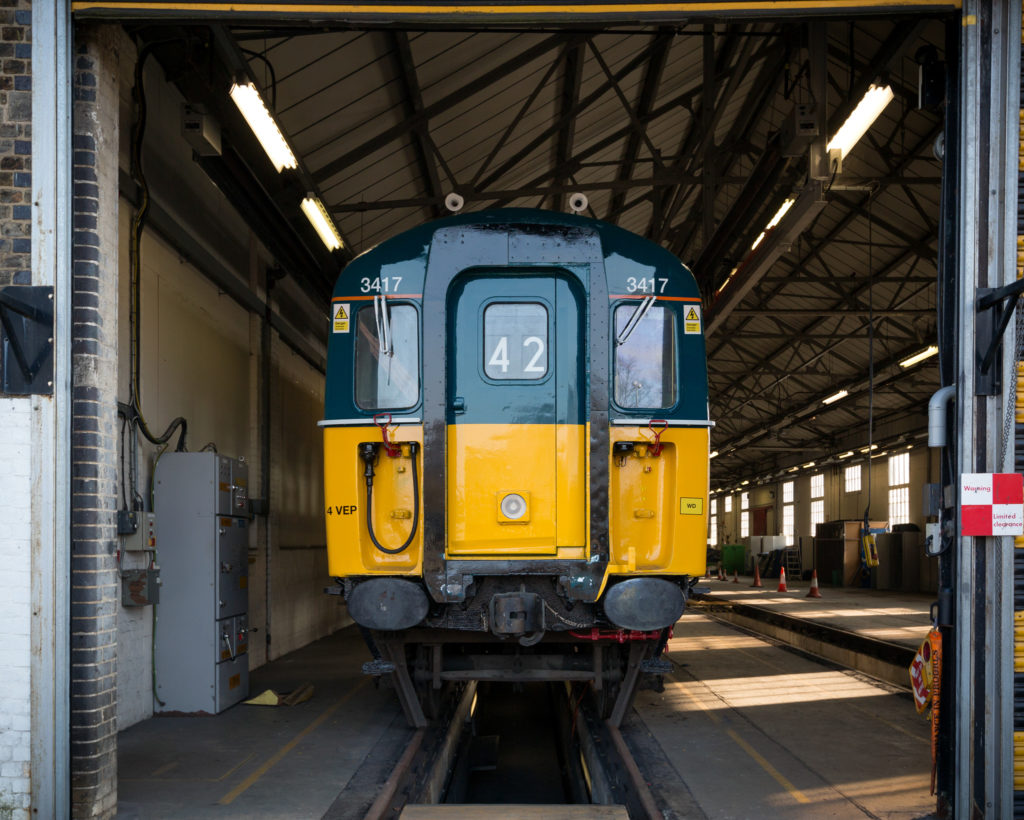Project Phoenix is a structured plan to restore unique 4VEP No. 3417 to running condition, from heritage railway operation towards our long-term aim of allowing 3417 to once again operate independently on the mainline.
The challenges standing in our way are large, and will involve careful planning and application of finances. But with thorough preparation and implementation none of the challenges are insurmountable. This page will illustrate the problems to be overcome to allow the unit to once again carry passengers and earn its keep.
Work has been ongoing at Strawberry Hill depot for the last 9 years, and after consultations we have structured and focussed our restoration efforts against a set of achievable goals.
PHASE ONE:
Phase One will involve achieving work to allow the unit to be hauled on the National Network, and to allow passengers to be carried on preserved railways. We have fond memories of visiting railways in the South of England, and enjoyed the reactions of the travelling public who arrived to ride on the unit.
Brake Exam
The first aspect of Phase One will be an overhaul of the 4VEPs brake system and re-certification of the air tanks. We are in a position to achieve some of this work ‘in-house’ but we will need to bring in outside expertise to overhaul the Brake Control Chests under each coach, and to have the air tanks ultrasonically tested. Should any tanks have insufficient depth of metal remaining (4VEPs were never fitted with an air-drying system, so moisture liberated from the air under compression can sit in the air tanks and corrode the internal surfaces) they will have to be removed and replaced. As well as this we will strip, service and rebuild the brake cylinders.

January 2024 Update:
Completed.
Step Boards
As the brake examination and overhaul is ongoing, we will also fit new step boards to each coach. Some of the boards had rotted through and would not support any load (in other words “passengers might fall through them”) so replacement of all the boards that are life expired is essential. Any boards which are still sound will remain in place. While we will not compromise on safety or standards, we are also not intending to spend money where money doesn’t need to be spent; funds will be directed to where they are most needed. Partially perished boards will be cut and any sound timber salvaged to make ‘new” small stepboards.

January 2024 Update:
Completed.
Internal Trim – Seating
The single largest task will be the restoration of the internal trim. We have previously carried out extensive research into sourcing the appropriate materials to re-upholster the unit and found the amount of money needed to meet the minimum order of raw materials was well beyond our current capabilities; £36,000. Fortunately we were invited to work alongside the National Railway Museum’s Project Commuter team, who are cosmetically restoring 2HAP No.4308. This allowed us to order just under 100 metres of trim which will allow us to begin refurbishing our passenger accommodation. This material was collected from the NRM in early August 2018. At the same time we also sourced a further 120 metres plus of suitable trim from the North Norfolk Railway which will move the project forward further. Both of these purchases were funded through our successful Crowdfunding appeal launched in 2017. Our depot at Strawberry Hill now has a small dedicated trim shop where we can begin to strip, salvage, retrim and produce fresh cushions and quarter pads for the unit as required. As part of the preservation process we will also treat the unit with insecticide to eliminate any of the remaining infestation of moths noted when the unit moved back from Ilford after refurbishment.

Update January 2024:
Completed.

Phase One Update January 2024:
Phase One of Project Phoenix has now been completed. All mechanical, electrical and interior work detailed above, plus all other related work has now been completed to allow the unit to transit via the National Network. 3417’s first journey in 9 years was completed on the 27th January 2024 between Strawberry Hill and London Waterloo. In September 2024 the unit visited the Bluebell Railway to attend their diesel gala. This was 3417’s first visit to any railway for an event in 11 years. The unit performed flawlessly, running for over 400 miles over 3 days. This was an ideal shake-down which proved the quality of the unit, the quality of the restoration carried out and highlighted areas for future development.

Project Phoenix Phase Two:
Phase Two will involve achieving work to allow the unit to work on the National Network under its own power, as well as continuing to allow passengers to be carried on preserved railways as required. In order to allow the unit to become a functioning traction unit again several issues will need to be resolved. These are listed below.
1. Global System for Mobile communications – Railway (GSM-R)
In order to satisfy current Office of Rail Regulation (ORR) and Rail Safety Standards Board (RSSB), the unit must as a minimum carry two pieces of safety-critical equipment which must be fully functional in both driving cabs for the unit to leave the shed without a piloting locomotive. The first of these is GSM-R, which allows the driver to be in full contact with any controlling signal box or signalling centre. The GSM-R allows trains to be stopped independent of a controlling signal through the Railway Emergency Call (REC) protocol, which, when a train receives an emergency stop message, requires the driver to bring the train to an immediate stand. The existing CSR (Cab Secure Radio) system fitted to the unit is obsolete and will be replaced. The SETG already has certain components to allow GSM-R to be fitted but will need to source further parts – either through corporate donation, sponsorship or through purchase from an approved manufacturer – and is making efforts to source all remaining parts to allow fitment of GSMR-R equipment to both driving cabs.
October 2024 Update:
See below.

2. On-Train Data Recorder (ODTR – also know as OTMR, On-Train Monitoring and Recording)
OTDR equipment is also a mandatory requirement for all UK locomotives and units which are to be driven on the mainline. It allows all control inputs, speed changes, brake pressures and other information to be recorded for examination at a later date. Circumstances under which information may be needed can include monitoring and assessment of driving quality and style, investigation of incidents and so on. The data is vital to demonstrating proper operation of the unit and having records of movements is vital to having a body of evidence to show proper operation of the unit by the crew.
The approximate cost of OTDR fitted as new, with preparation of drawings, fitting and certification will be approximately £5,000 per driving cab. This will include sourcing appropriate spares to allow robust operation.
October 2024 Update:
See below.

3. Controlled Emission Toilet Equipment (CET)
CET equipment is now mandatory on all passenger-carrying rolling stock, and while is isn’t compulsory for 3417 to be fitted (since we could lock the existing facilities out of use), it is our intention to ensure that 3417 is as comfortable and amenable as possible to future passengers.

October 2024 Update:
See below.
4. Central Door Locking Equipment (CDL)
Central door locking equipment, like CET equipment, is now mandatory for all passenger-carrying vehicles. However, unlike toilet facilities which can be locked out of use, the unit must be fitted with central door locking in order to carry passengers in mainline service.

October 2024 Update:
See below.
Project Phoenix Phase Two – October 2024 Update:
After the twin successes of our trip to Waterloo in January and the our successful visit to the Bluebell Railway in September, the unit is now stopped for the winter. CME Chris Buckland has a program of works in place to further improve the fabric of the unit. These works, involving all aspects of the unit from existing systems to installing further upgrades, will ensure that 3417 is in the best possible condition for 2025. The VEP is back and will keep on getting better!
As part of Phase Two of Project Phoenix, we have identified that CDL and CET equipment will be our first priorities for upgrading, since without them we cannot carry passengers in mainline traffic. Having the unit driven under its own power is of a lower priority than ensuring that we can allow the travelling public aboard – the unit can be quite safely topped & tailed by suitable locomotives which would already carry their own GSM-R & OTMR equipment. This does not preclude the unit being able to use it’s own power equipment, and we are working towards allowing this for ECS moves in the short term. Accordingly our efforts for fundraising will be primarily focussed on CDL & CET equipment initially, with any excess funds being directed to GSM-R in the first instance and OTMR secondly. Funds allowing, we would like to install these systems simultaneously if possible to avoid dismantling the cab and internal fittings twice!
We will continue to provide updates on Phase Two as time permits.

We continue to welcome the encouragement and support you have given through our Facebook and Twitter accounts and, as finances and circumstances allow, our work will continue to bring 3417 back into passenger service.
